The difference between success and failure in Forex trading is very likely to depend mostly upon which currency pairs you choose to trade each week and in which direction, and not on the exact trading methods you might use to determine trade entries and exits.
When starting the trading week, it is a good idea to look at the big picture of what is developing in the market as a whole and how such developments and affected by macro fundamentals and market sentiment.
The world is beginning to see a sentiment rebound from a major geopolitical crisis which is producing a few strong trends in the markets, so it is an interesting time to be trading.
Fundamental Analysis & Market Sentiment
I wrote in my previous piece last week that the best trade for the week was likely to be long of Corn and USD/JPY, and short of GBP/USD. USD/JPY rose by 1.60%, GBP/USD fell by 1.07%, and Corn fell by 1.48%, giving a small averaged loss of 0.32%. However, if you had only traded the Forex pairs, you would have achieved an averaged profit of 0.27%.
The news remains dominated by the Russian invasion of Ukraine which is now well into its fourth week. However, it no longer seems to be having much impact on markets, with all the commodities it boosted, most notably crude oil and wheat, falling back to more normal prices. It seems that Ukrainian forces have fought the Russians close to a standstill. Clearly, the Ukrainian defense has been far more effective than the Russian leadership or anyone else anticipated, and Russian losses may already be exceeding 10,000 dead troops – nearly two thirds the Soviet Union’s total losses in the 10-year war in Afghanistan in the 1980s. Strong sanctions have been placed on Russia and the Russian economy, with many multinational companies pulling out of Russia or shutting down operations and sales there, while several Russian banks have been cut off from SWIFT. Russian assets abroad are also being seized and frozen. This is going to cause a great deal of economic pain in a country where a lot of people are already barely getting by paycheck to paycheck. The USA has banned Russian oil imports, but EU and other nations are refusing to do so.
Despite the worrying conflict in Ukraine, markets have shifted towards a risk-on sentiment and pattern over the past week, with stock markets rising, risky currencies strong, and the Japanese Yen weak. This can probably be explained by three factors:
Markets have recovered from the initial shock of the Russian invasion of Ukraine, which is now seen as unlikely to spiral into a wider conflict, or even to end in any kind of Russian victory. This view is boosted by the fact that Russia and Ukraine are holding what seem to be more serious peace talks.
The Bank of Japan has reacted to Japan’s relatively low (in G7 terms) inflation rate, which remains below the Bank’s target of 2%, by saying it will continue with a dovish monetary policy until 2% inflation is reached. This makes the Bank of Japan very divergent from almost all other major central banks which are tightening policy and gives a strong tailwind to a continued weakening of the Japanese Yen.
The Federal Reserve last week hiked rates by 0.25% as expected, rather than making a more dramatic hike of 0.50%, and markets were impressed by this and the strong rhetoric against inflation given by the Chair of the Fed Jerome Powell.
In other news last week:
The Bank of England hiked its official bank rate by 0.25% to 0.75%, with fewer members voting for a stronger 0.50% rate hike than had been expected.
US retail sales and PPI data came in lower than expected, raising some hope of a weakening of underlying inflationary pressure.
Canadian CPI (inflation) data came in slightly higher than had been expected, showing a monthly increase of 1.0% compared to the 0.9% which had been expected.
Australian employment data came in stronger than had been expected, with the unemployment rate declining to 4.0% from 4.2% when a rate of 4.1% had been anticipated.
New Zealand GDP data came in lower than expected, showing a quarterly increase of 3.0% when 3.3% had been expected.
Last week saw the global number of confirmed new coronavirus cases rise again for the second consecutive week for the first time since January. Approximately 64% of the global population has now received at least one vaccination.
The strongest growths in new confirmed coronavirus cases overall right now are happening in Australia, Austria, Bhutan, Cyprus, Germany, Greece, Italy, Laos, Luxembourg, Malta, Monaco, Switzerland, Thailand, the UK, and Vietnam.
The Week Ahead: 20th – 25th March 2022
The coming week in the markets is likely to be dominated by continuing risk-on sentiment unless there is an escalation over Ukraine. This suggests rising stock markets, and in the Forex market, a weakening Japanese Yen while other non-USD currencies continue to strengthen, with a relatively high level of volatility.
There a few several economic data releases due this week, in order of probable importance:
British CPI (inflation) data and UK Annual Budget
Swiss National Bank Monetary Policy Assessment, Policy Rate, and press conference
German Flash Manufacturing & Services PMI data
Technical Analysis
U.S. Dollar Index
The weekly price chart below shows the U.S. Dollar Index fell last week, despite the long-term bullish trend. However, Dollar bulls will be encouraged that the nearest support level, shown in blue at 12293 within the below price chart, has continued to hold, giving hope that the greenback will resume its advance.
It may be wise to look to other currencies as key drivers of the Forex market over the coming week, as we are seeing most pronounced movements against the Japanese Yen, and in favor of non-USD currencies, especially commodity currencies such as the Australian Dollar.
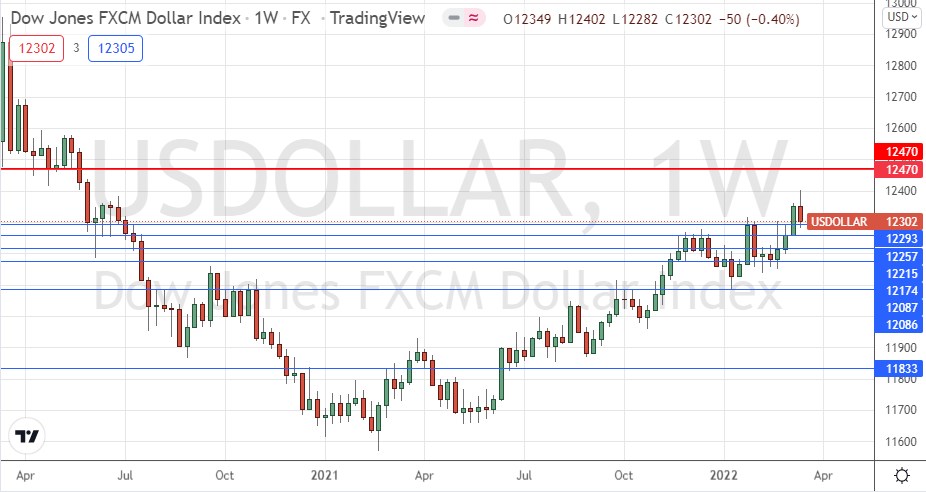
S&P 500 Index
The world’s most important stock market index, the S&P 500, rose firmly last week, despite earlier making the first “death cross” / “bear cross” (50 day moving average crosses below the 200-day moving average) seen since the coronavirus shock of March 2020.
The price closed Friday with strong short-term bullish momentum just a fraction below the 200-day moving average. If the price can now get established above that moving average, it will be a bullish sign that the bull market is likely to continue after pulling itself out of correction territory.
There is an obvious key resistance level at 4596.
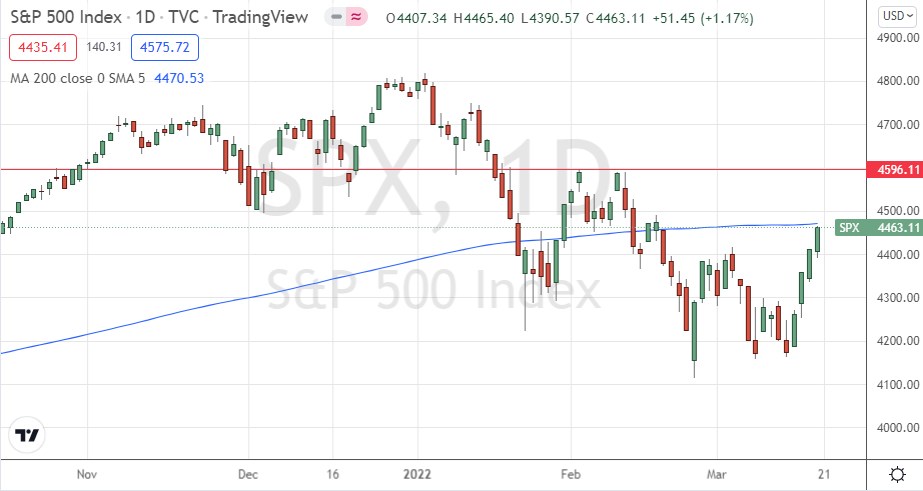
USD/JPY
The USD/JPY made a second consecutive unusually strong weekly rise last week, closing near its high at its highest closing price seen in over 6 years. These are very bullish signs, with the Japanese Yen showing the greatest weakness of all major currencies putting this pair in focus right now. I made a good call last week seeing this pair as a buy.
There are two reasons for bulls to be cautious here: firstly, although the Japanese Yen is clearly the weakest currency, the US Dollar is not showing short-term strength, so it may be better to trade Yen currency crosses long over the coming week, such as AUD/JPY as the Aussie is showing strong momentum. Secondly, this currency pair has reached an area of resistance stretching from about 119.15 to the big round number overhead at 120.00, which may slow or even halt its advance.
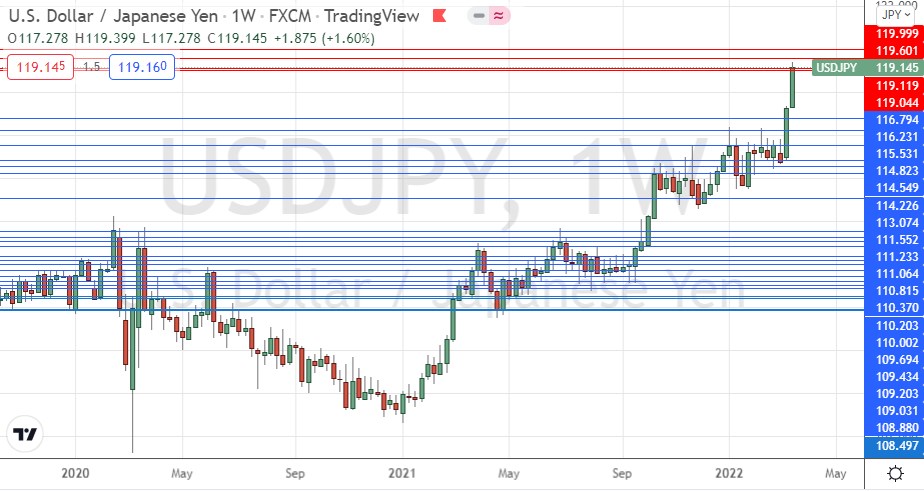
AUD/JPY
Over the past week and during the calendar month of March, the Australian Dollar has been the strongest currency while the Japanese Yen has been the weakest. This currency cross is at the heart of the Forex market now. The Yen is weak as the Bank of Japan wants to bring inflation up to 2%, while the Australian Dollar is strong on improving global risk sentiment and a relatively buoyant commodities sector concerning Australian exports.
Technically, the price has powered to a new 4-year high price, but bulls should be warned this currency cross can turn sour very quickly, especially if there is any surprising escalation in Ukraine.
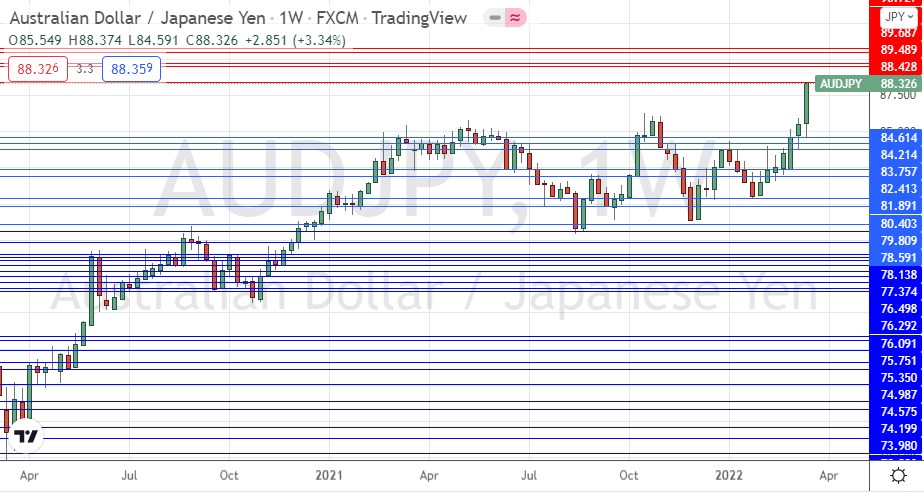
Cotton
Cotton has been in a very reliable bullish trend ever since April 2020 and rose strongly last week on above-average volatility to close at a multi-year high. Going long of Cotton can therefore be interesting to trend traders now, but allowances should be made for the typically high volatility of this commodity, in common with other agricultural commodities. Small position sizes should be used.
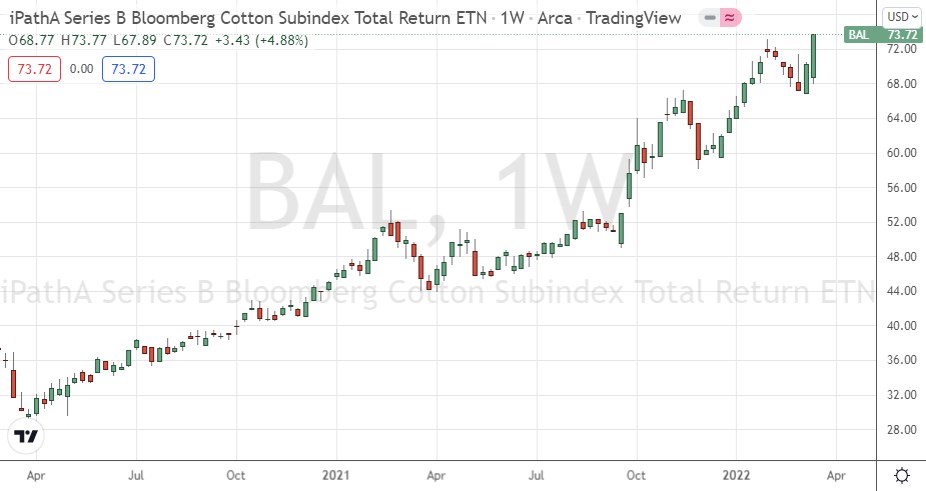
Bottom Line
I see the best opportunities in the financial markets this week as likely to be long of USD/JPY, and possibly long day trades on very strong bullish momentum in the S&P 500 Index.
